Harvard Library
The Harvard Library is the umbrella organization for the Harvard University libraries and their shared services, such as access, preservation, digital infrastructure, digital imaging, and discovery services. The Harvard Library is nearly 400 years old, making it the oldest library system in the United States. Additionally, the Harvard Library is the largest private library system and largest academic library in the world.[4][5] Its collection holds nearly 20 million volumes, 400 million manuscripts, 10 million photographs, and one million maps.[6]
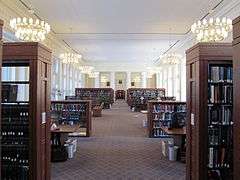 | |
| Type | Academic library system of Harvard University |
|---|---|
| Established | 1638[1] |
| Location | Cambridge, Massachusetts |
| Coordinates | 42.3733923°N 71.1186862°W |
| Branches | 28 |
| Collection | |
| Items collected | more than 20.4 million volumes, 180,000 serial titles, an estimated 400 million manuscript items, 10 million photographs, 124 million archived web pages, and 5.4 terabytes of born-digital archives and manuscripts.[2] |
| Size | 20.4 million (2020) |
| Access and use | |
| Circulation | 733,890[3] (2013) |
| Other information | |
| Budget | US$160 million (2014) |
| Staff | around 800 total (2020)[2] |
| Website | library |
| Map | |
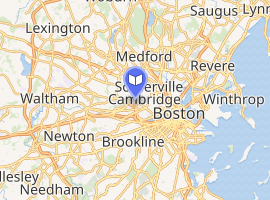
| |
Harvard Library holds the third largest collection in the United States, after the Library of Congress and Boston Public Library. Based on the number of items held, it is the fifth largest library in the United States.[7] Additionally, Harvard is part of the Research Collections and Preservation Consortium (ReCAP) along with Columbia Libraries, Princeton University Library and New York Public Library, and the Ivy Plus Libraries Confederation, making over 90 million books available to the library's users.[8]
The library is open to current Harvard affiliates, and some events and spaces are open to the public. The most recognized building in the Harvard system is Widener Library, situated in Harvard Yard.
History
Harvard's library system grew due to donations from prominent individuals, John Harvard being one of them and John Hull being another (The History of Harvard University – Josiah Quincy -pg 407). John Harvard was a Puritan minister who accumulated 400 books spreading word of his faith. These volumes were left to Harvard, initiating the library's collection. The works in this collection soon became obsolete, as Harvard Library quickly changed to an academic institute and found little need for the theological titles.
The location of the library changed over time. Originally it was in the Old College building. In 1676, the library was moved to Harvard Hall, which was where it remained until the building burnt down during the fire in 1764. The fire of 1764 destroyed the entire collection. Quickly after, a new Harvard Hall was built and 15,000 books were collected to create the new library.[9] As time went on space became limited in Harvard Hall, and the library was moved to Gore Hall in 1841. Eventually, Gore Hall was no longer suitable and the books were moved elsewhere in 1912. Around this time, the library spread into more than one building. Some of the libraries were devoted to specialized topics.[10]
Over the next century the library grew to become the largest in America, but on January 24, 1764, a major fire destroyed almost all of Harvard's books and scientific instruments. All of the books in the library at the time of the fire were completely burned. The books that had been loaned out when the fire occurred were the only portion of the collection that remained.[10] Books and donations were offered by friends of the college to replace its collections. An eccentric Englishman, Thomas Hollis V of Lincoln's Inn, London, (great-nephew of one of the University's early benefactors), began shipping thousands of specially chosen volumes to the University Library. Hollis continued to send books regularly until his death in 1774 and he also bequeathed £500 for a fund to continue buying books. This became Harvard's first endowed book fund, and is still actively increasing the collections every year. Harvard Library's online catalog, HOLLIS[11] (a bacronym for "Harvard On-Line Library Information System"), is named after him.
Some books were digitized within the Google Books Library Project,[12] which began as a project developed with leadership and oversight by former Director Sidney Verba.
On August 1, 2012, a new Harvard Library organization began operations, designed to improve a fragmented system of 73 libraries across Harvard's Schools with one that promotes University-wide collaboration. Functions that occur within all libraries—Access Services, Technical Services and Preservation Services—were unified to enable greater focus on the needs of the user community. The new structure was developed from recommendations of the Task Force on University Libraries and the Library Implementation Working Group.[13]
Holdings
In addition to millions of volumes, the Harvard Library also houses a range of historical artifacts and primary documents from around the world, including one of only 23 complete Gutenberg Bibles.[14] The largest collection of East Asian-language material outside of East Asia is held in the Harvard-Yenching Library.[15]
The largest collection of archives focused on business and economic history is housed in the Baker Library Special Collections at Harvard Business School. The Botany Libraries’ archives include Henry David Thoreau’s personal herbaria, letters from Charles Darwin to Asa Gray, and thousands of botanical illustrations. The Wolbach Library holds the oldest surviving images of the moon, and the Tozzer Library is one of the oldest anthropological libraries in the world.
Harvard Library also has a robust collection of digital content. More than 6 million digital objects are accessible online by anyone, regardless of whether or not they're affiliated with Harvard, via the Harvard Digital Collections page.[16]
The CURIOSity tool offers another way to explore Harvard's digital collections, providing curated views, specialized search options and discovery of unique content. Curated collections include the Colonial North America archive, the Islamic Heritage Project, and over 3,5000 digitized daguerreotypes.[17]
Publications
By 1973, the Harvard Library had authored or published over 430 volumes in print, as well as nine periodicals and seven annual publications. Among these is a monthly newsletter, The Harvard Librarian, as well as a quarterly journal, the Harvard Library Bulletin. The latter was established in 1947, and was dormant from 1960 until being revived in 1967.[18] The Bulletin is published three times a year in spring, summer, and fall. Anyone can subscribe to receive the Harvard Library Bulletin, and an archive of past issues is available on the Harvard Library website.[19]
Organizational structure
The Harvard Library is the formal name for an administrative entity within the central administration that oversees the development and implementation of strategies that facilitate access to research, collections, services, and space in ways that raise the value of the university's investment in its libraries.As of June 2019, Martha Whitehead is the current vice president for the Harvard Library and the Roy E. Larsen Librarian of the Faculty of Arts and Sciences.[20] The Harvard Library consists of:
- Access Services connects the academic community to the vast array of library resources.
- Information and Technical Services is responsible for acquiring, licensing and providing access to tangible and online collections in all formats.
- Preservation, Conservation and Digital Imaging Services is committed to ensuring that library materials remain secure and usable for contemporary and future scholars by conserving materials, digitizing collections, preserving library content in digital formats and providing robust education and outreach programs.
- The Harvard University Archives is the institutional archives of the University. It oversees the University's permanent records, collects Harvard-related manuscripts, papers, and historical materials, and supervises records management across the University.
- Finance supports the library by providing accurate information that assists decision-making, maintaining the integrity of finance systems and completing financial transactions.
- Program Management ensures that potential projects and approved projects are managed in a considered, predictable and transparent way.
- The Office for Scholarly Communication provides for open access to works of scholarship produced by the Harvard community.
Governance
Library Visiting Committee
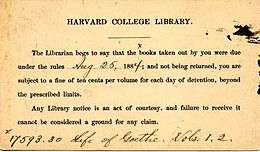
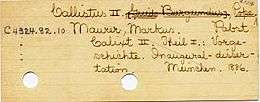
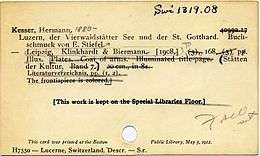


Visiting Committee members are experts and Harvard alumni who are appointed by the corporation. The Committee oversees the strategy and administration of the Harvard Library on behalf of the Overseers. Bi-annual visits and regular updates by the Office of the Provost provide an opportunity for Visiting Committee members to understand and advise on the Harvard Library's progress.
Library Board
The Library Board is charged with reviewing the strategic plans of the Harvard Library and assessing its progress in meeting those plans, reviewing system-wide policies and standards and overseeing the progress of the central services. The provost chairs the Library Board (established in December 2010) and the Office of the Provost is responsible for overseeing the Harvard Library. The Harvard Library Board is composed of six permanent members and five rotating members who serve three years each, with their initial terms staggered. The permanent members are the provost, the Carl H. Pforzheimer University Professor and the deans or designees from the following Schools: the Faculty of Arts and Sciences, Harvard Business School, Harvard Law School and Harvard Medical School.
The rotating members consist of three at-large, tenured faculty members, as well as deans or designees from the Harvard Kennedy School, Harvard Graduate School of Design, Harvard Divinity School, Harvard Graduate School of Education, Harvard School of Public Health, Harvard School of Engineering and Applied Sciences and Radcliffe Institute.
Faculty Advisory Committee
The establishment of the Harvard Library Faculty Advisory Council in 2011 brought together faculty from across the University. The Council advises the Library Board and the two groups meet together twice a year. Robert Darnton, Pforzheimer Professor, is the chair and James Engell, Gurney Professor of English Literature, is the vice-chair.
Library Council on Student Experience
Established in 2012, the Library Council on Student Experience is a joint council consisting of librarians and students from across the University who identify and work together on University-wide priorities identified by the council for improving the student library experience. The council is co-chaired by a librarian appointed by the vice president for the Harvard Library and by a student elected from the student council members. Students and librarians are nominated by the School library directors and selected by the Office of the Provost. Other members include representatives from the Tell Us project, the Berkman Institute and Harvard Library Shared Services. Terms are for two academic years. The Council makes recommendations to and is supported by the vice president for the Harvard Library.
Library Leadership Team
The Harvard Library Leadership Team is responsible for planning, prioritizing and implementing joint library initiatives. The team works with the vice president for the Harvard Library to develop and implement library-wide strategy and policy approved by the Board in collaboration with other standing committees and working groups. Chaired by the vice president for the Harvard Library, the Team includes members of the library's senior management team, library directors from the ten professional schools and the Radcliffe Institute, the managing director of Library Technology Services (HUIT), the Harvard Library shared services heads, the Harvard Library Director of Communications, and the Director of Diversity, Equity, and Inclusion for Harvard Library.
Libraries at Harvard
Along with shared services such as circulation, cataloging, and preservation, the libraries below make up the larger Harvard Library:[21]
- Andover-Harvard Theological Library (Harvard Divinity School)[22]
- Arnold Arboretum Horticultural Library
- Baker Library (Harvard Business School)[23]
- Biblioteca Berenson (Florence, Italy)
- Botany Libraries
- Cabot Science Library
- Countway Library (Harvard Medical School & Harvard T.H. Chan School of Public Health)[24]
- Dumbarton Oaks Research Library (Washington, DC)
- Ernst Mayr Library of the Museum of Comparative Zoology[25]
- Fine Arts Library[26]
- Fung Library[27]
- Gutman Library (Harvard Graduate School of Education)[28]
- Harvard Film Archive
- Harvard Kennedy School Library and Knowledge Services[29]
- Harvard Law School Library[30]
- Harvard Map Collection[31]
- Harvard University Archives
- Harvard-Yenching Library
- Houghton Library
- Lamont Library
- Loeb Music Library[32]
- Loeb Design Library (Harvard Graduate School of Design)[33]
- Robbins Library of Philosophy[34]
- Schlesinger Library on the History of Women in America (Radcliffe Institute)[35]
- Tozzer Library[36]
- Widener Library
- Wolbach Library[37]
Librarians
|
|
|
See also
- Google Books Library Project
- Dataverse
- Boston Medical Library
- JHOVE
- List of online image archives
References
- Harvard Library (February 14, 2011). "About the Harvard Library". Harvard Library. Harvard University. Archived from the original on January 7, 2013. Retrieved January 16, 2013.
- Harvard Media Relations. "Quick Facts". Retrieved September 4, 2019.
- Harvard University (2013). "Harvard Library Annual Report FY 2013". Harvard Library. Archived from the original on June 9, 2016. Retrieved March 17, 2015.
- Karl, Thomas (1998). Toward an Earth Science Enterprise Federation: Results from a Workshop. National Academies Press. p. 27. ISBN 0-309-06134-2.
- Pezzi, Bryan (2000). Massachusetts. Weigl Publishers. p. 15. ISBN 1-930954-35-2.
- "Harvard Library | Harvard University - The Graduate School of Arts and Sciences". gsas.harvard.edu. Retrieved August 9, 2019.
- American Library Association, "ALA Library Fact Sheet 22 – The Nation's Largest Libraries: A Listing by Volumes Held". October 2012.
- "Harvard Library joins forces to bring 90 million books to users". Harvard Gazette. June 6, 2019. Retrieved August 9, 2019.
- 1948-, Murray, Stuart (2009). The library : an illustrated history. New York, NY: Skyhorse Pub. ISBN 978-1602397064. OCLC 277203534.CS1 maint: numeric names: authors list (link)
- Burke, Sarah K. "Bookish fires: the legacy of fire in the Harvard libraries" (PDF). Harvard Library. Archived from the original (PDF) on October 26, 2014. Retrieved October 26, 2014.
- https://images.hollis.harvard.edu/primo-explore/search?vid=HVD_IMAGES&lang=en_US&sortby=rank
- "Library Partners -- Google Books". hul.harvard.edu.
- "Report of the Task Force on University Libraries" (PDF). hwpi.harvard.edu.
- "The Gutenberg Bible". Harvard Library. Retrieved August 9, 2019.
- "Harvard-Yenching Library". Harvard Library. Retrieved August 9, 2019.
- "Harvard Digital Collections". Harvard Library. Retrieved August 9, 2019.
- "CURIOSity Digital Collections". curiosity.lib.harvard.edu. Retrieved August 9, 2019.
- Kent, Allen; Lancour, Harold; Daily, Jay E., eds. (1973). "Harvard University Library". Encyclopedia of Library and Information Science, Volume 10: Encyclopedia of Library and Information Science: Volume 10 - Ghana: Libraries in to Hong Kong: Libraries in. CRC Press. ISBN 9780824721107.
- "Harvard Library Bulletin". Harvard Library. Retrieved July 18, 2019.
- "New Leader for Harvard University". February 12, 2019. Retrieved June 12, 2019.
- "Locations & Hours". Harvard Library. Retrieved August 9, 2019.
- "Andover-Harvard Theological Library". library.hds.harvard.edu. Retrieved August 9, 2019.
- "Baker Library | Bloomberg Center | Harvard Business School". www.library.hbs.edu. Retrieved August 9, 2019.
- "Countway Library | Countway Library". www.countway.harvard.edu. Retrieved August 9, 2019.
- "Ernst Mayr Library". library.mcz.harvard.edu. Retrieved August 9, 2019.
- "Fine Arts Library". Harvard Library. Retrieved August 9, 2019.
- "Fung Library". Harvard Library. Retrieved August 9, 2019.
- "Gutman Library". Harvard Graduate School of Education. Retrieved August 9, 2019.
- "Library & Knowledge Services". www.hks.harvard.edu. Retrieved August 9, 2019.
- "Harvard Law School Library". Harvard Law School. Retrieved August 9, 2019.
- "Harvard Map Collection". Harvard Library. Retrieved May 5, 2020.
- "Loeb Music Library". Harvard Library. Retrieved August 9, 2019.
- "Frances Loeb Library - Harvard Graduate School of Design". www.gsd.harvard.edu. Retrieved August 9, 2019.
- "Robbins Library". philosophy.fas.harvard.edu. Retrieved August 9, 2019.
- "Schlesinger Library". Radcliffe Institute for Advanced Study at Harvard University. February 16, 2012. Retrieved August 9, 2019.
- "Tozzer Library". Harvard Library. Retrieved August 9, 2019.
- "John G. Wolbach Library". library.cfa.harvard.edu. Retrieved August 9, 2019.
- Alfred Claghorn Potter, Charles Knowles Bolton (1897), The Librarians of Harvard College 1667-1877, Cambridge, Mass: Library of Harvard University, OL 7223959M
- Librarian pro tem in 1737, per Sibley's Harvard Graduates. 9. p. 501. OCLC 950913670.
https://archive.org/stream/archaeologiaame03amer#page/n263/mode/2up
Further reading
- "History of the Library." In The Library of Harvard University: Descriptive and Historical Notes, 4th ed., 12–35. Cambridge: Harvard University Press, 1934.
- Carpenter, Kenneth E. The First 350 Years of the Harvard University Library: Description of an Exhibition. Cambridge: Harvard University Press, 1986.
- Bond, W. H. and Hugh Amory, eds. The Printed Catalogues of the Harvard College Library, 1723–1790. Boston: The Colonial Society of Massachusetts, 1996.
- Kraus, J. W. (1961). The Harvard Undergraduate Library of 1773. College & Research Libraries, 22(4), 247–252.
- Olsen, M., & Harvey, L. G. (1993). Reading in revolutionary times: book borrowing from the Harvard College Library, 1773–1782. Harvard Library Bulletin, 4, 57–72.
External links
| Wikimedia Commons has media related to Harvard University Library. |